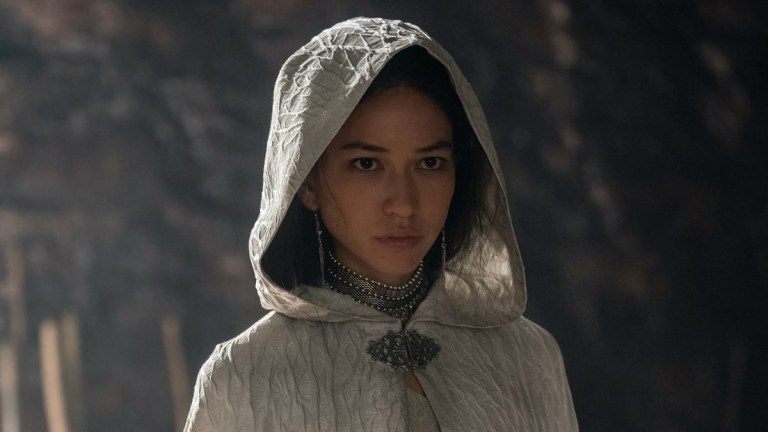House of the Dragon: Who is Lady Mysaria, the White Worm?
Sonoya Mizuno plays Lady Mysaria on House of the Dragon: a Lyseni woman with questionable motives.

This article contains light spoilers for Fire & Blood.
Though the monetary units of the Seven Kingdoms are coins known as “gold dragons,” everyone knows the real currency of Westeros is secrets. Gathering secret information and exploiting it for personal gain is how one can win the game of thrones…or even more importantly: avoid losing it.
We see this ever-important dynamic play out in House of the Dragon episode 4 “King of the Narrow Sea.” When Daemon Targaryen (Matt Smith) invites his niece Rhaenyra (Milly Alcock) on a romantic night out on the town (ick), the sun doesn’t even have a chance to rise before someone has spied that juicy gossip and put it to good use. The very next morning the Hand of the King Ser Otto Hightower (Rhys Ifans) brings news of Daemon’s transgressions to his brother, King Viserys I (Paddy Considine).
But how did Otto glean this information so quickly? The answer lies in an important character who has existed around House of the Dragon‘s margins thus far: Lady Mysaria of Lys a.k.a. The White Worm (Sonoya Mizuno).
Mysaria has been a presence on House of the Dragon from episode 1 onward. In the show’s first hour, she is a sex worker in a King’s Landing pleasure house, who just happens to be a favorite paramour of Daemon. By episode 2 she is supposedly his betrothed wife, though the two never actually married and Daemon appears to be trolling his brother. Now, in episode 4, she proudly announces to Daemon that she’s outgrown her experience in the Westerosi brothel scene and is off to bigger and better things. She’s a spy now.
In episode 4, we get to see a nondescript boy deliver sensitive intel to Otto Hightower and mention that it comes from the “White Worm.” Since Mysaria later basically admits that it was her who ratted Daemon out, White Worm is clearly her nom de plume in the Westerosi espionage game. Why is she called that though? And where exactly does she come from? Most importantly: why is she important to the story the show is trying to tell?
The answer to all of those questions lie, as they often do, in George R.R. Martin’s books. Let’s start with where Mysaria is from first, as it helps establish much her character.
Where is Lys?
The history of the nine city-states of Essos known as the “Free Cities” are fleshed out in Martin’s main A Song of Ice and Fire saga and a handful of other texts. The encyclopedic The World of Ice and Fire and the alternate history book Fire & Blood (upon which most of House of the Dragon is based) contain the most useful information regarding Lys’s culture, geography, and politics.
Eight of the nine Free Cities (with Braavos as the exception) were once western outposts of the House Targaryen’s ancestral home, the Valyrian Freehold. After a cataclysm known as the Doom of Valyria all but wiped that empire off the map, nine of the Freehold’s cities continued on in western Essos like business as usual.
As King Viserys’s Small Council notes in House of the Dragon’s first episode, the Free Cities rarely, if ever, pose a military threat to the Seven Kingdoms in Westeros. Occasionally, a handful of cities will rally around a charismatic leader or cause. We saw this happen on House of the Dragon as The Triarchy, an alliance of Lys, Myr, and Tyrosh, gathered under the leadership of Craghas “Crabfeeder” Drahar. For the most part, however, all nine Free Cities are happy to operate as independent entities and frequent trading partners of Westeros.
Of the nine Free Cities, Lys is perhaps the most beautiful and populous (though its precise population is not known). The city resides upon several rocky islands off the western coast of Essos. Its people are known as the Lyseni. Like many of the other Free Cities, Lys is primarily concerned with trade and its natural splendor and relative safety make for excellent capitalistic conditions. Along with the ample trading that goes on in Lys, the city is particularly hospitable to its male guests thanks to the many “pillow houses” and “pleasure gardens” that dot the island.
What’s interestings about Lys from the books, and House of the Dragon’s subsequent deviation from it, is that the city is said to be the most “Valyrian” of all the Free Cities. The Lyseni people are said to resemble Valyrians, having the same blond hair and lilac eyes that House Targaryen is known for. Of course, in House of the Dragon, Mysaria has dark hair and does not have a similar appearance to any Targaryen we know.
It’s possible that House of the Dragon’s Mysaria is not “ethnically” Lyseni but rather Lyseni in the sense that she was a resident of a pillow house in Lys. It’s also possible that House of the Dragon has just decided to not worry about the appearance of Free City residents so long as they appear sufficiently different from the main characters.
Why is Mysaria The White Worm?
In George R.R. Martin’s continuity, Mysaria is known to her enemies as “Lady Misery, the White Worm.” The white worm aspect seems to derive from her extremely pale, milky Valyrian skin. Since Mysaria’s appearance has changed a bit for the TV show, the “White Worm” designation is probably just an unassuming code name on Otto Hightower’s part. Or it could refer to her penchant for wearing white robes.
In any case, Lady Mysaria is set to play a fairly major role in the wars to come. As evidenced by her time working for Otto, she is very adapt in the arts of espionage and sabotage. With Otto now fired and off the board, someone else will have to step forward and put Mysaria’s talents to good use.
